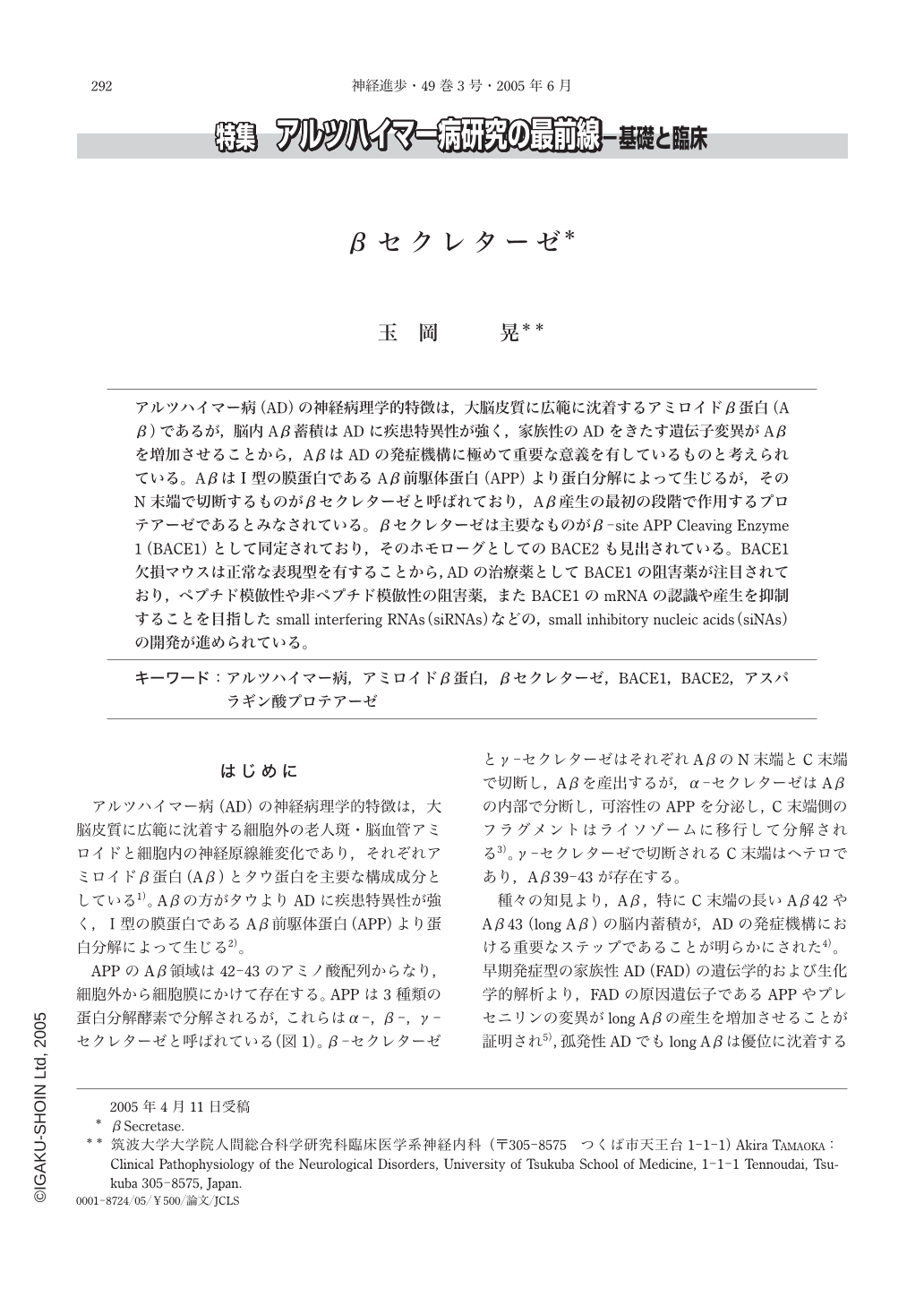Japanese
English
- 有料閲覧
- Abstract 文献概要
- 1ページ目 Look Inside
アルツハイマー病(AD)の神経病理学的特徴は,大脳皮質に広範に沈着するアミロイドβ蛋白(Aβ)であるが,脳内Aβ蓄積はADに疾患特異性が強く,家族性のADをきたす遺伝子変異がAβを増加させることから,AβはADの発症機構に極めて重要な意義を有しているものと考えられている。AβはⅠ型の膜蛋白であるAβ前駆体蛋白(APP)より蛋白分解によって生じるが,そのN末端で切断するものがβセクレターゼと呼ばれており,Aβ産生の最初の段階で作用するプロテアーゼであるとみなされている。βセクレターゼは主要なものがβ-site APP Cleaving Enzyme 1(BACE1)として同定されており,そのホモローグとしてのBACE2も見出されている。BACE1欠損マウスは正常な表現型を有することから,ADの治療薬としてBACE1の阻害薬が注目されており,ペプチド模倣性や非ペプチド模倣性の阻害薬,またBACE1のmRNAの認識や産生を抑制することを目指したsmall interfering RNAs(siRNAs)などの,small inhibitory nucleic acids(siNAs)の開発が進められている。
Several lines of evidences suggest that amyloid β protein(Aβ) is crucially important to the pathophysiology of Alzheimer's disease(AD). Senile plaques, primarily composed of Aβ, progressively develop in the brains of AD patients, and mutations in three genes[amyloid precursor protein(APP), presenilin 1(PS1), and presenilin 2(PS2)]cause early onset familial AD(FAD)by increasing toxic Aβ42 peptide, whereas apolipoprotein-ε4, one of the strongest risk factors for AD, enhances Aβ40. Down syndrome patients, who all develop early-onset AD, have an extra copy of the APP gene on chromosome 21 and thus overexpress both Aβ40 and Aβ42. Because of such a strong association between AD and Aβ, therapeutic strategies to decrease the concentration of Aβ in the brain should be beneficial for the treatment of AD.
Aβ is a proteolytic product of the APP, which is a large TypeⅠ membrane protein. Two proteases, calledβ-andγ-secretase, cleave APP to generate Aβ peptide. Recently, γ-secretase has been tentatively identified as the presenilin complex, whose major components are PS1 and PS2, whileβ-secretase has been shown to be the novel transmembrane aspartic protease,β-site APP Cleaving Enzyme 1(BACE1;also called Asp2 and memapsin2). BACE2, a novel protease homologous to BACE1, was also found, and the two BACE enzymes are considered to belong to a new family of transmembrane aspartic proteases. Since BACE1 shows all the properties of theβ-secretase and BACE1 knock out mice reveal apparently normal phenotype, this key enzyme initiating the formation of Aβ is an attractive drug target for AD.
First of all, substrate-based peptidomimetic BACE inhibitors were designed using the knowledge of the specificity and kinetics of BACE. These include peptidic hydroxyethylene BACE inhibitor, peptide statine based BACE inhibitors and so on. It is notable that the sizes of the modified inhibitors recently reported are comparable to a number of approved peptidomimetic HIV protease inhibitor drugs. The identification of nonpeptidomimetic inhibitors of BACE1 has also appeared to be challenging. Such inhibitors include minoethyl-substituted tetralins, piperazine-substituted phosphinyl-and phosphorylmethyl succinic acid derivatives, and halogen-substituted niarylnaphthalenes. In addition, strategies targeting BACE mRNA recognition and its down-regulation based on the antisense action of small inhibitory nucleic acids(siNAs)are now noteworthy. These include antisense oligonucleotides, catalytic nucleic acids as well as small interfering RNAs(siRNAs).

Copyright © 2005, Igaku-Shoin Ltd. All rights reserved.


